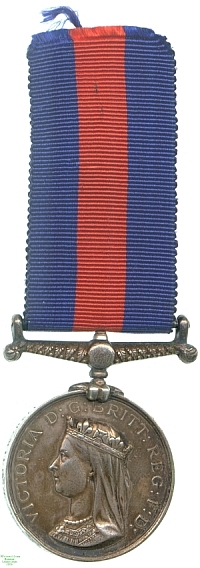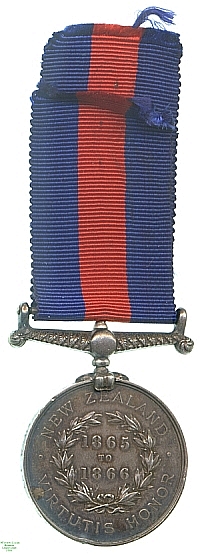
Obverse, a bust of Queen Victoria with veil

Reverse, laurel wreath within the inscription

Obverse, a bust of Queen Victoria with veil |

Reverse, laurel wreath within the inscription |
The New Zealand Medal was instituted in 1869 to recognise service in the New Zealand Wars of 1845-46, 1847 and 1860-66, though not for any of the other conflicts in that or a wider period in the islands. The phrase New Zealand Wars covers a variety of affrays, whose common factors were relatively few beyond that all, at some level, involved government forces suppressing risings by the indigenous Maori peoples. The background to the conflicts was misunderstandings and lapses, more or less wilful from case to case, in the implementation of the Treaty of Waitangi by which in 1840 the newly-instituted New Zealand government had protected the Maori tribes from loss of their lands. Not all the conflicts for which the New Zealand Medal was awarded were of this kind, however, some rather being wars between Maori tribes in which one side had managed to engage the government.
There were twenty-eight different sorts of New Zealand Medal awarded, of which twenty-seven bore the dates of different periods of service, some of which overlapped or enveloped the periods of other issues. There was also an undated medal issued for those whose service dates were no longer recorded, which might serve for any of the other twenty-seven.
The dates on this medal relate to the conflict known as the Second Taranaki War. This differed from the First Taranaki War, which had been fought inconclusively between 1860 and 1861 over a disputed land sale in the Waitara area which the New Zealand government was forced to retrocede, by the new presence of the religious movement known as the Pai Marire, or, when taken to the battlefield against the wishes of their pacifist prophet Te Ua, the Hau Hau. Although when their campaigns against the settlers began in 1864 their early beliefs of invulnerability were quickly dashed, their mass attacks they adopted (often resisted by non-believing Maori as much as colonialists) presented a worrying new threat. Governmental response to this was fragmented, as Cameron and his men, backed by the British government in London, were resistant to what they increasingly saw as a land-grab despite the urging of their superiors in Auckland. Fighting continued desultorily through 1865, with the British military only committing to battle when they had either a manifestly superior position or Maori support.
In 1866 the New Zealand Government renewed campaigning in a more serious fashion but a disastrous campaign across Taranaki Province in which a substantial force nearly starved determined the British Government to withdraw Imperial troops. Many men took their discharge in New Zealand and joined the local militia, and the New Zealand government was thus freed of some of its strictures. This made the final campaigns of 1866 rather more bloody; entire Maori villages were systematically destroyed and their supplies burnt, and political opposition to the methods of the campaign finally brought the Second Taranaki War to a close in November.
This medal was awarded to Private Miles Lawless of the 2nd Battalion, 18th Royal Irish Regiment. Lester Watson purchased the medal from the dealer Lowe at some point before 1928.